|
|
Advertisement:
|
|
Intel 925XE Chipset and 3.46GHz Extreme Edition CPU |
|
Join the community - in the OCAU Forums!
|
Test Configuration, Benchmarking
Tweaking and overclocking has not been possible with Intel motherboards so far. The first exception was the 875P based Intel D875PBZ (aka “Bonanza”) motherboard. The 925XE based D925XCV2 now offers even more tweaking features. It allows adjusting the memory timings and the memory voltage up to 2.1 volts.
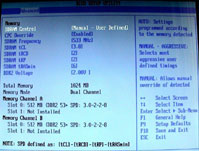 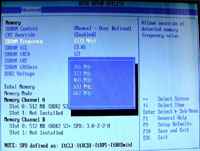
Interestingly the D925XECV2 BIOS allows you to run the system memory at 667 MHz. DDR2 memory with this frequency is already an endorsed JEDEC industry standard, but Intel chipsets do not officially support DDR2 667. It is said that this official support will come with the successor chipsets to the 900 series. DDR 667 support is definitely available with the D925XCV2, assuming of course that the memory modules are good for this speed. Running the system memory at 2x338 MHz = DDR 667 MHz instead of the validated stock frequency of 2x266 MHz = DDR 533 MHz does mean though that it is asynchronously communicating with the CPU through the system bus running at a base speed of 266 MHz. The D925XE allows adjusting the frequencies of the PCI bus, and it includes a “burn-in” function which is Intel’s name for “overclocking”.
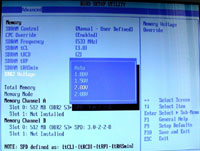 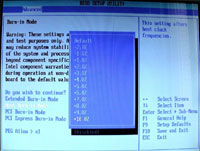
For system “burn-in” the BIOS allows you to adjust the system bus 2% downward and 10% upward from stock speed. This setting allows in theory to run the system bus at 266 MHz + 10% = 293 MHz and a 3.46 GHz at 13 x 293 = 3809 MHz. Unfortunately the D925XCV2 BIOS which was available at the time of our test didn’t allow adjusting the processor voltage. We will report on the last page how much the lack of this feature is affecting overclocking with this board.
TEST CONFIGURATION:
The main objective of our tests was to quantify the impact of increasing the system bus frequency from 800 MHz to 1066 MHz. For this purpose we compared the just-released 3.46 GHz EE with the 3.40 GHz EE. These two processors are running at almost the same clock speed. They are identical with the exception of the system bus (FSB) frequency and multiplier. The 3.46 GHz EE is running at 1066 MHz FSB and the 3.40 GHz EE at 800 MHz FSB. Any difference in performance should therefore be the result of the different system bus frequency. Additionally it is interesting to see how the new 3.46 GHz Extreme Edition fares against a “standard” Pentium 4 at the same clock speed. We have therefore included in our tests a Pentium 4 550 clocked a 3.40 GHz. This processor is based on the newer 0.09 micron Prescott core, is running with an 800 MHz system bus, clocked at 17 x 200 MHz and comes with 1 MB level 2 cache. In order to show the potential of the 925XE chipset we are using Crucial Ballistix DDR2 667 which runs at the 925XE validated stock frequency of 533 MHz with relatively tight timings of CL 3, RDC 3, RP 3 and RASmin 8. Another objective of our tests was to evaluate major 925XE features and for this we will test hard disk performance when using Intel’s Matrix RAID technology.
We benchmarked with the following system configuration:- P4 3.46 GHz Extreme Edition (Gallatin) / 1066 MHz system bus / 2 MB L3 cache / Intel engineering sample with 12x and 13x multiplier selection
- P4 3.40 GHz Extreme Edition (Gallatin) / 800 MHz system bus / 2 MB L3 cache
- P4 3.40 GHz (Prescott) / 800 MHz system bus / 1 MB L2 cache
- Crucial Ballistix DDR2 667 memory running at 533 MHz, timings: CL 3, RDC 3, RP 3, RASmin 8
- Intel D925XE motherboard, BIOS revision 15 October 2005
- Windows XP Pro, SP 2, DirectX 9c
- 4 SATA Western Digital WD740GB hard disk drives
- 1 PATA Maxtor Diamond Plus 9 160 GB (OS installation)
- ATI Radeon 800XT PCI-Express video card with Catalyst drivers 6.14.10.6490
We used the following benchmarking software:- SiSoft Sandra 2004
- Sciencemark 2.0 beta
- PCMark 2004 Pro
- Business and Content Creation Winstone 2004
- 3DMark 2001, 2003, and 2005
- Comanche 4
- Doom 3
- Unreal Tournament 2004
TEST RESULTS:
Our first tests were aiming at CPU performance and memory bandwidth. The SiSoft Sandra 2004 and PCMark 2004 CPU tests don’t show much difference in the raw performance of these 3 processors.
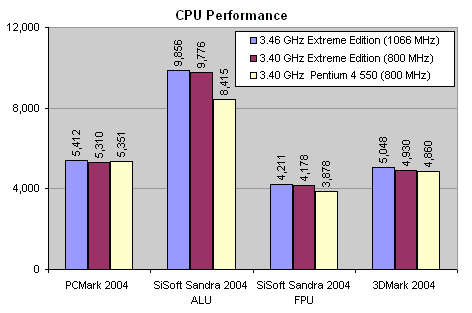
The 3.46 GHz EE is leading the 3.40 GHz EE by a miniscule 2%. That does not come as a surprise as the 3.46 GHz EE is running only 60 MHz faster in core speed. When it comes to memory bandwidth, the 3.46 GHz EE based system shows its muscles and we see a much different picture.
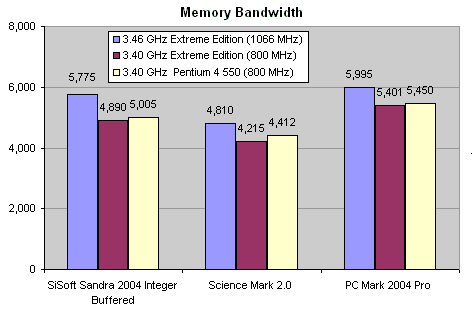
SiSoft Sandra shows that increasing the system bus frequency from 800 to 1066 MHz is boosting actual bandwidth from around 4900 MB/sec to 5800 MB/sec. That’s a healthy gain of almost 19%. Sciencemark and PCMark show similar gains.
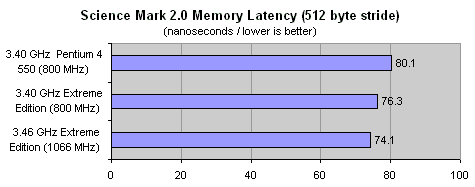
Sciencemark 2.0 shows that memory latency improved by 3.0%. It is interesting to see that the Prescott based Pentium 4 550 is beating the 3.40 GHz EE in all 3 bandwidth tests. We can assume therefore that a Prescott based Extreme Edition with a 1066 MHz system bus would do even better than the Gallatin based 3.46 GHz EE. Roadmaps show that Intel is already planning to use the Prescott core for the next Extreme Edition, sporting 2 MB L2 instead of the Gallatin’s slower 2 MB L3 cache.
|
|
Advertisement:
All original content copyright James Rolfe.
All rights reserved. No reproduction allowed without written permission.
Interested in advertising on OCAU? Contact us for info.
|

|


